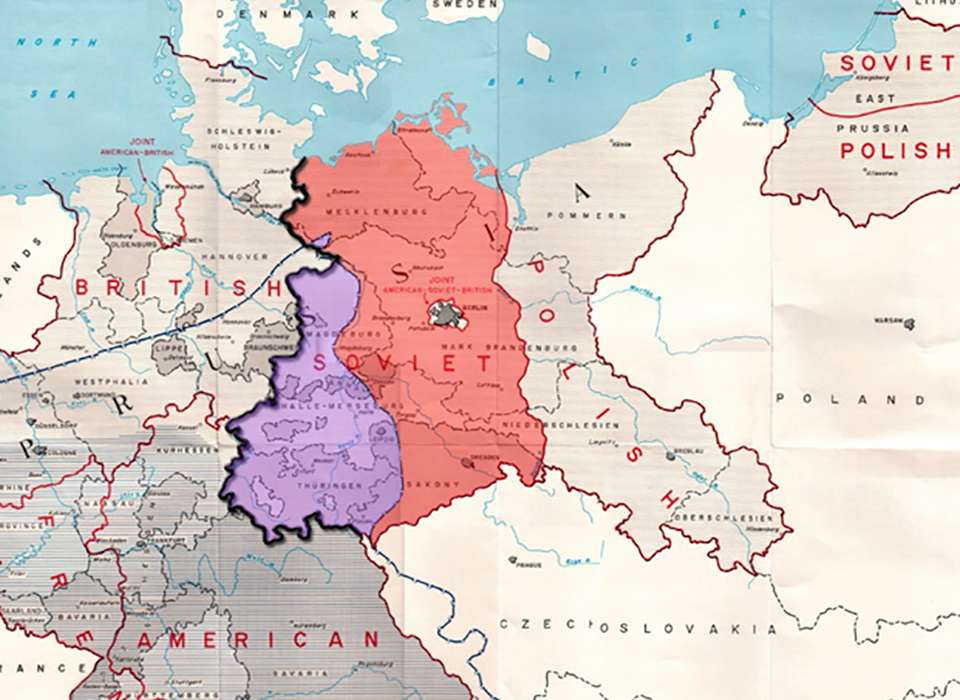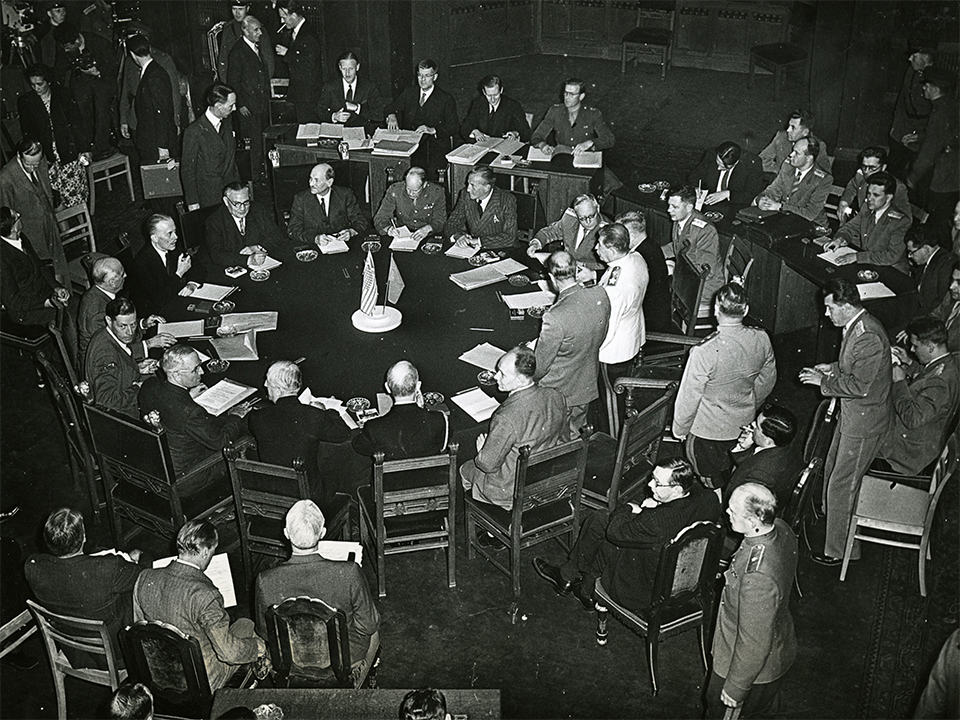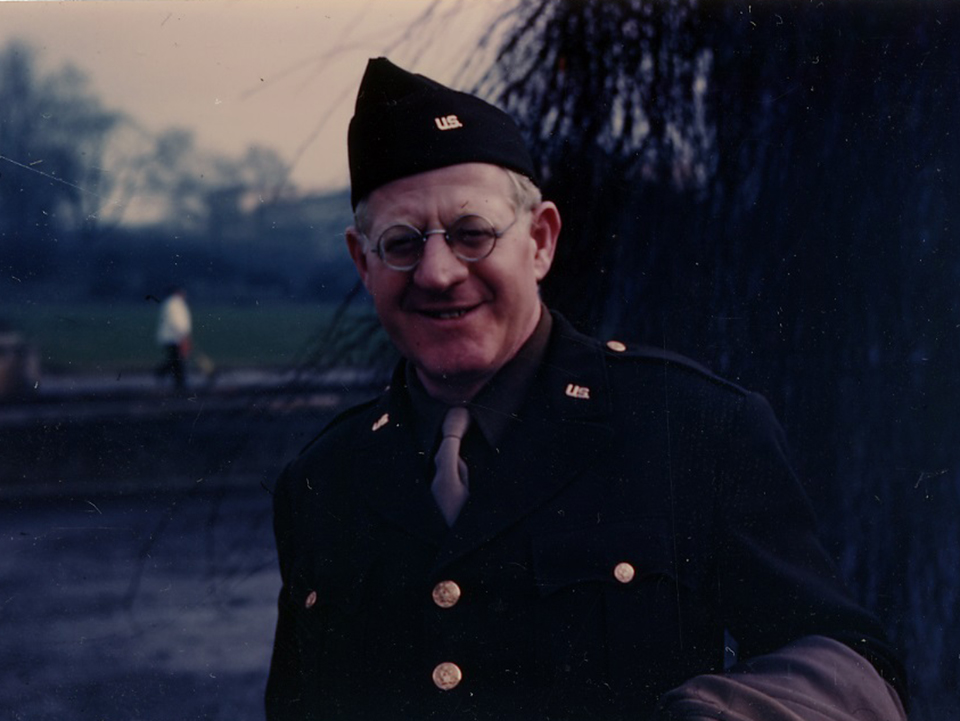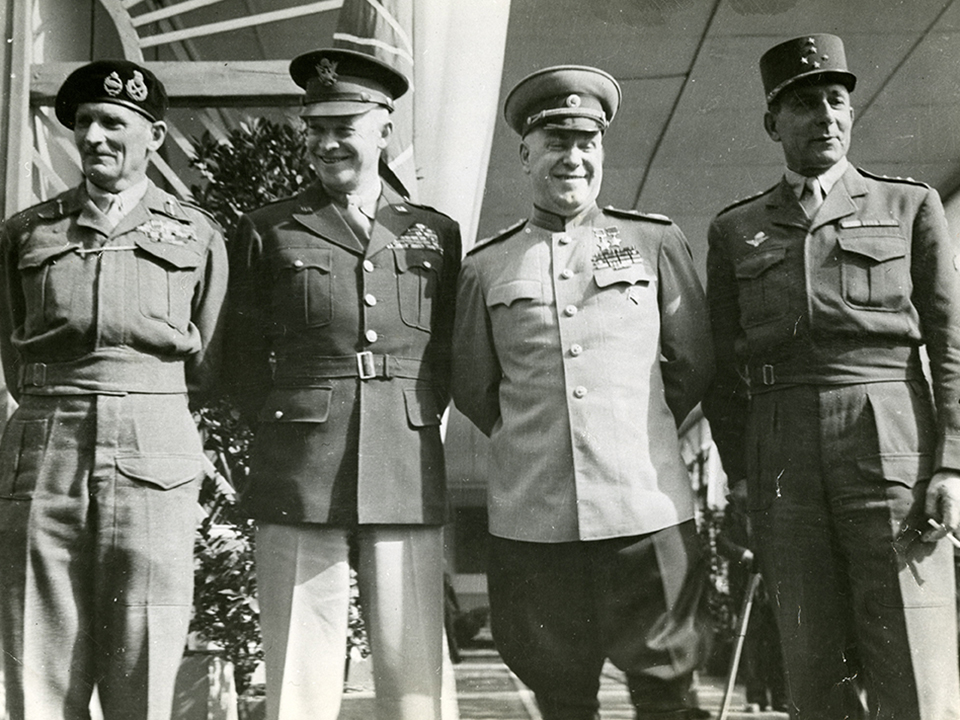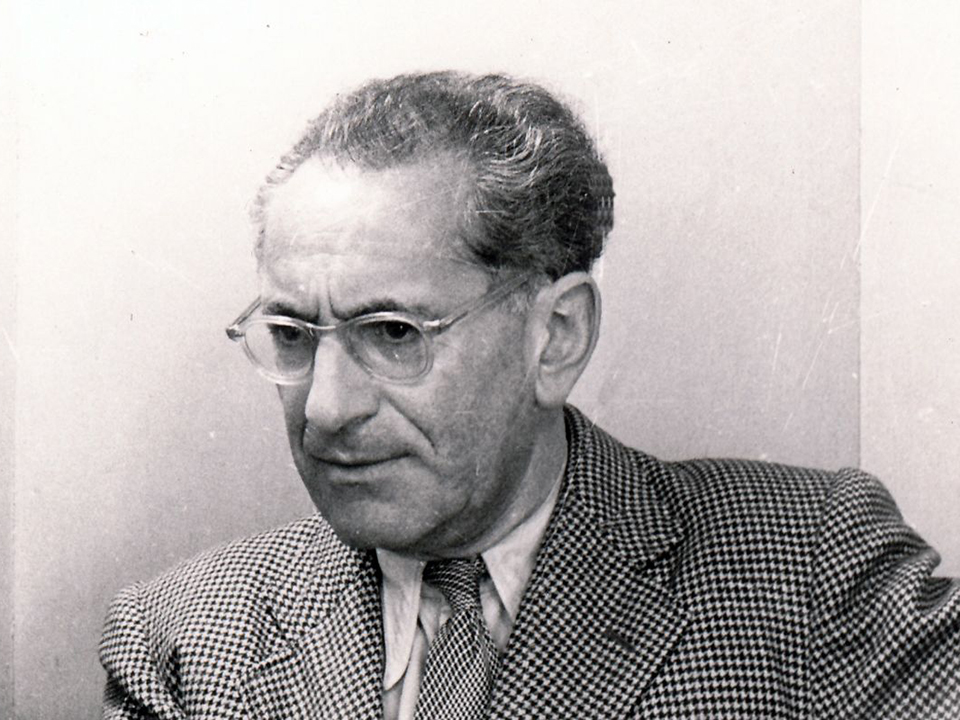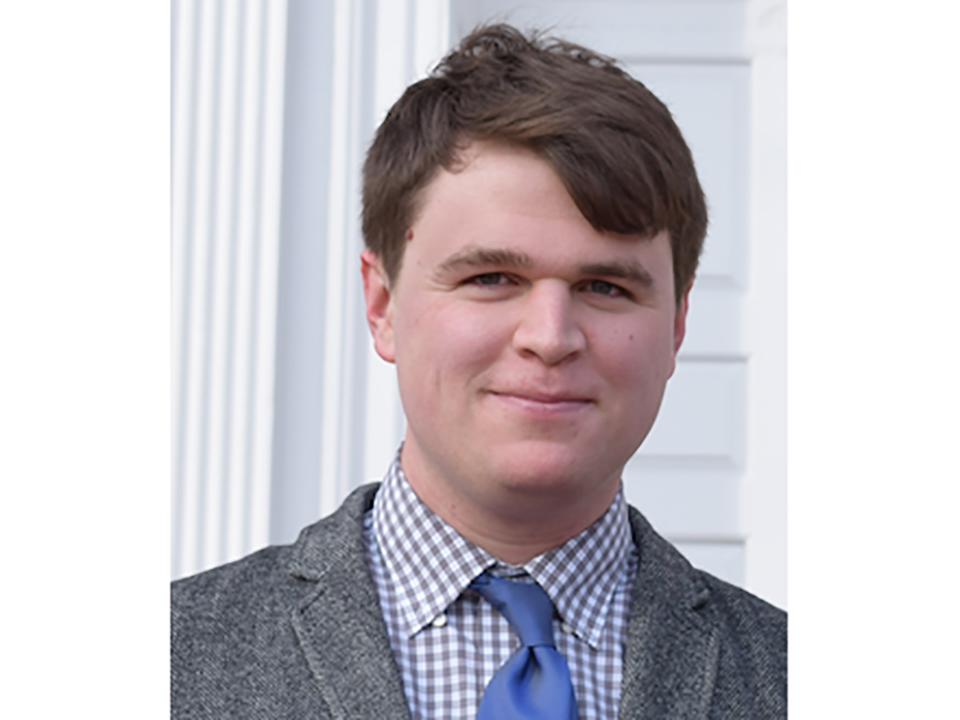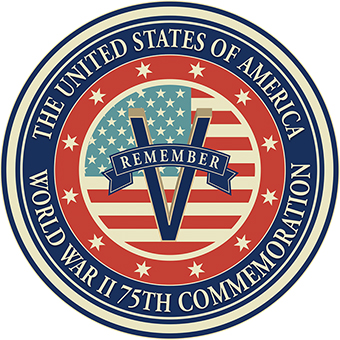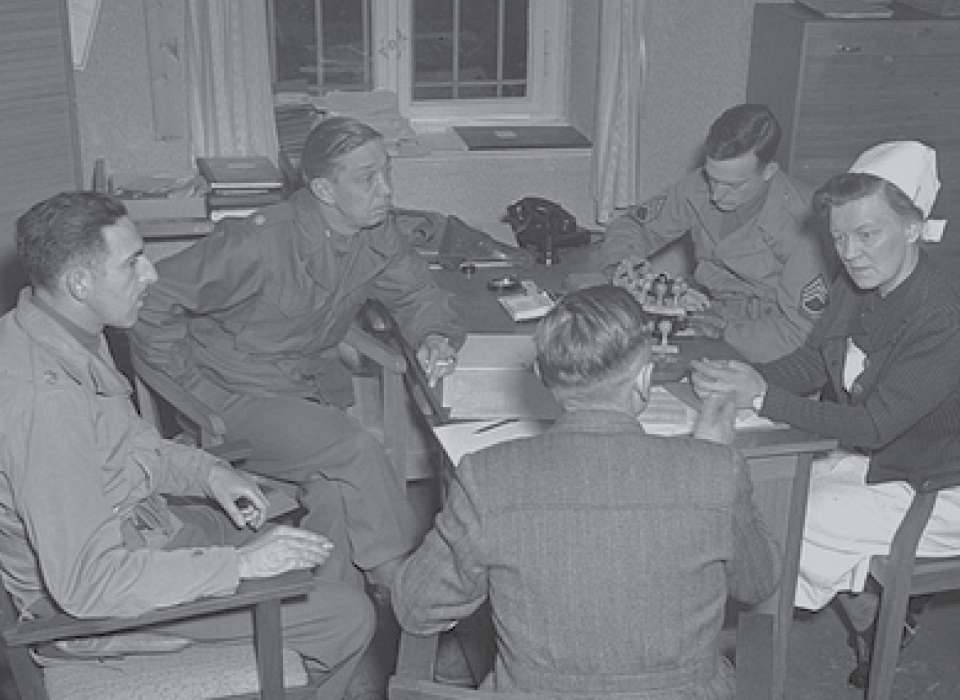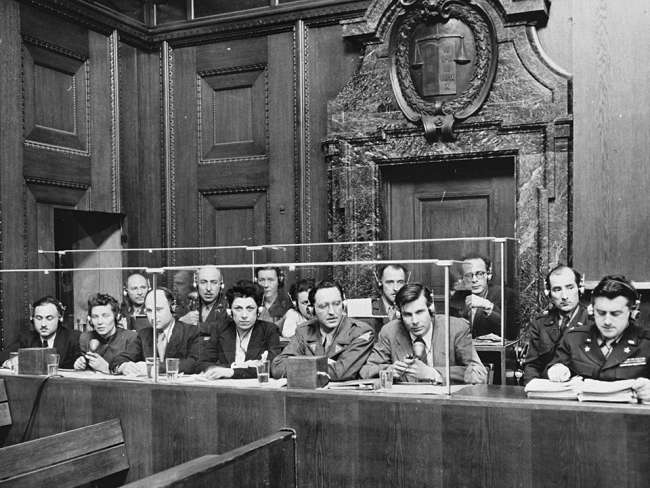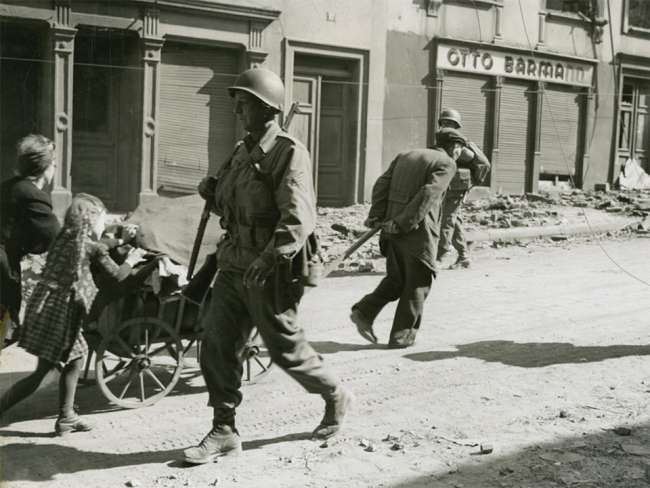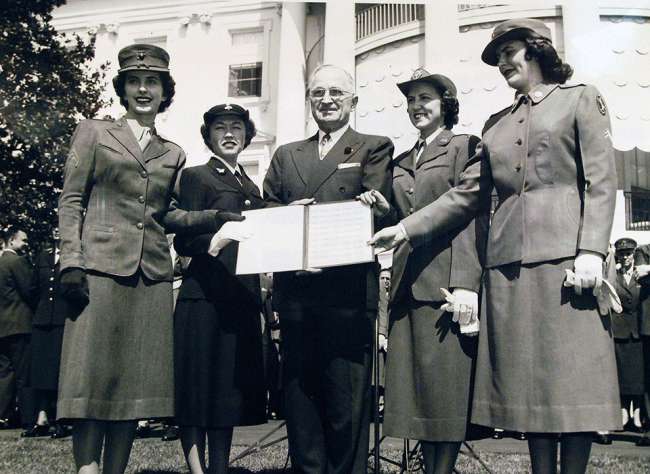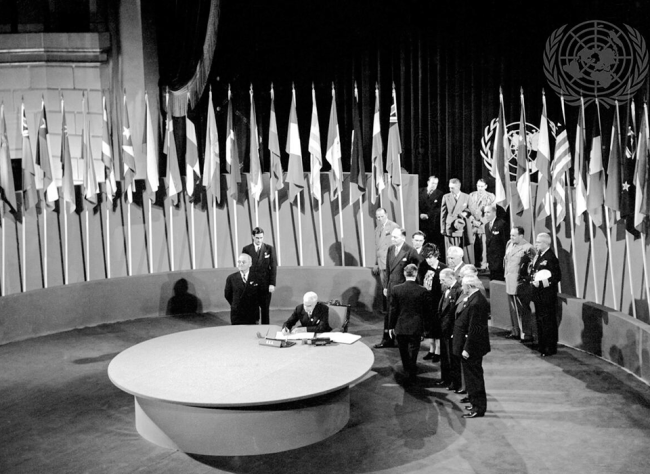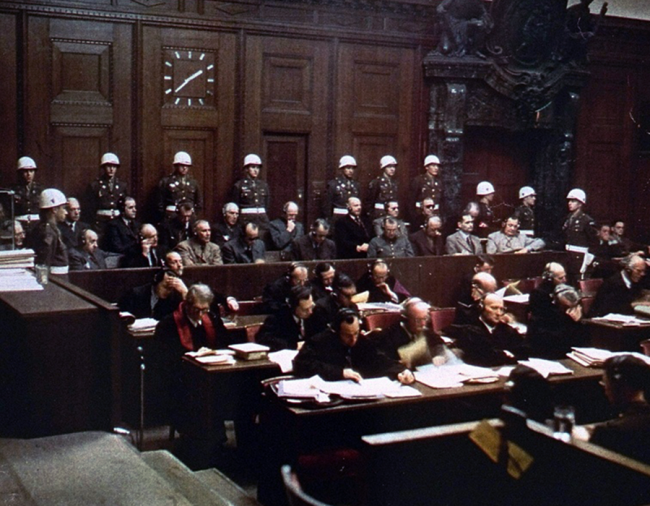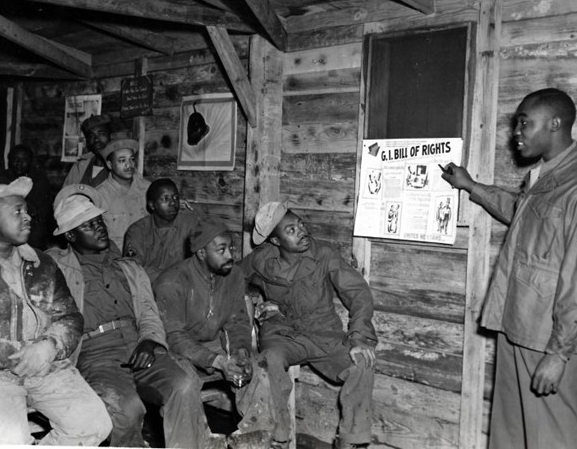Top Image: Map of occupied Germany in 1946. The US Zone included the modern states of Bavaria, Hesse, and part of Baden-Württemberg, as well as the city of Bremen. Map from Earl F. Ziemke, The US Army in the Occupation of Germany, 1975. Courtesy of Wikimedia Commons.
In 1935, the Nazi jurist and future major war criminal Hans Frank—who would be responsible for many of the Nazis’ worst crimes in German-occupied Poland during World War II and was hanged in 1946 after conviction in the Nuremberg Trials—wrote in an introduction to the book The National Socialist Handbook for Law and Legislative Processes that “law is that which serves the German Volk, illegality is that which harms it.” This was the guiding principle of German law from 1933-1945.
Law served the Volksgemeinschaft (in this context meaning the “racial community”) by persecuting “dangerous elements” such as Jews, communists, social democrats, and “career criminals.” It policed the “racial community” by preventing “miscegenation” and providing warrants to imprison real and supposed enemies of the regime in “protective custody” without defense or trial.
“Our legal understanding must, in the first instance, serve the preservation of the racial community… The individual cannot be the main point of legal concerns, but rather the Volk”
Adolf Hitler
Like so many authoritarian regimes, Nazi jurists relied on euphemism to mask the antisemitic and racist outcomes of their measures. The 1933 “Law for the Restoration of the Professional Civil Service” forced Jews and political opponents of Nazism out of Germany’s expansive civil service. The Nazi government decreed laws to keep farms in the hands of ethnic Germans and pronatalist legislation to increase birth rates among ethnic Germans.
“Hereditary Health Courts” mandated sterilization for hundreds-of-thousands of disabled people, especially persecuting ethnic minorities living in Germany. “Special courts” were set up to speedily handle politically delicate cases important to the Nazi regime without recourse to due process. Of great consequence, the judicial system regulated the persecution and eventual murder of the European Jews.
Jurists wrote and enforced laws removing Jews from public service, set their own racialist view of Jewish identity with the “Nuremberg Race Laws,” and eventually enforced laws disenfranchising, despoiling, and ghettoizing German Jews. The judiciary had a crucial role in consolidating the regime and destroying a democratic justice system.
Like other apparatuses of the Nazi state, World War II brought out the murderous radicalism of the Nazi legal system. During the war, the power and scope of “special courts” and drumhead courts spread. These courts judicially murdered thousands of the slave laborers brought to Germany, resisters both foreign and domestic, German soldiers accused of desertion and cowardice, and eventually German civilians looking to surrender.
All told, between 1933 and 1945, the German judiciary passed roughly 80,000 death sentences, the vast majority of which were carried out. Countless more victims were unjustly sentenced to incarceration and died in prisons or concentration camps. A large percentage of the planners of the Holocaust came from the judiciary. Men from the security apparatuses, ministries, and civil services—those groups Hannah Arendt described as “desk murderers” (Schreibtischtäter)—overwhelmingly came from the legal profession, marking just how much every step of the judicial process from training to the highest courts was active in the Nazi regime.
Occupation
As the Allies conquered Germany, it was clear that the Germans were not going to rebel en masse against the Nazis. The fanatical German resistance and the liberation of concentration camps showing the world the extent of Nazi criminality hardened the US military’s approach to occupation, paving the way for the adoption of Joint Chiefs of Staff (JCS) Directive 1067. JCS 1067 called for a hard peace. It was to “be brought home to the Germans that Germany’s ruthless warfare and the fanatical Nazi resistance have destroyed the German economy and made the chaos and suffering inevitable” and that Germans had “brought [this] upon themselves.”
Germany was “not to be occupied for the purpose of liberation but as a defeated enemy nation.” JCS 1067 called for mandatory arrest of many accused Nazis. Around 170,000 people in the US Zone comprising the states of Bavaria, Hesse, and Württemberg-Baden were interned without trial in the first months of occupation.
The punitive language of JCS 1067 was soon eclipsed by the reconstructionist edicts of the Potsdam Conference. At Potsdam, the Allies set a fourfold goal of “demilitarization, denazification, decentralization, and democratization.” The reconstruction of law and the legal order was at the heart of the final three guiding principles. The Allies declared they would rid the law of National Socialist influence. This required expunging Nazi influence from legal codes and removing jurists who had been deeply involved in the Nazi regime.
While the United States, the United Kingdom, and much of the English-speaking world operate under precedent-based common law, Germany operates under a system of civil law. Civil law means the law follows a set of written legal codes relating to interaction between private citizens (also called civil law), criminal law, and state or constitutional law. Either the Allies had to abolish the German Civil/Criminal Codes of the nineteenth century in their entirety and rewrite them, or they had to comb through every governmental act of the Nazi regime to root out all signs of Nazi ideology.
The governing body of the four occupying powers, the Allied Control Council (ACC) in Berlin, chose to pursue the latter strategy. This meant hiring an army of lawyers to supervise the reconstruction of German legal systems. The Nazi persecution of democratically-minded jurists with Jewish origins or politically opposed to Nazism meant there was a ready-made pool of emigre lawyers who had the language requirements, experience with German law, and knowledge of personalities to pursue a thorough denazification of German law.
Lawyers working for the United States Military Government (OMGUS) pored through German legal codes and attempted to root out all traces of Nazi influence from the myriad corners of law: from labor and marriage law to corporate and contract law.
One person very qualified to sift through the byzantine web of German laws and administrative acts was the German-Jewish emigre lawyer Karl Loewenstein. He was hired by OMGUS to serve as an adviser to the occupation’s “Legal Division.” Lowenstein was an astute observer of German and Allied affairs, whose influence on the occupation was dulled only by his constant and withering criticism of his colleagues for their supposed ignorance of German affairs. His assessment that the early return of sovereignty to the Germans would pave the way to a return of Nazis to public life proved prescient. In the early days of the occupation, Loewenstein and other German emigres working for the Allies helped select legal officials, assuring that certain key positions were held by anti-Nazis.
Karl Loewenstein in his US military civilian uniform, somewhere in occupied Germany ca. 1946. Courtesy of The Karl Loewenstein Papers, Amherst College Archives and Special Collections.
The Potsdam Declarations demanded that Germany be treated as a single administrative unit. Despite this, legal reconstruction was carried out unevenly in each zone of occupation, often reflecting the different attitudes of occupying powers towards Nazi Germany, as well occupiers’ national legal traditions. The French occupation, fearing a revanchist German state on its border, sought to limit any centralized government to an absolute minimum. The Soviets allowed for an early centralization of political power in line with their desire to break up Prussia’s military tradition and large farm estates in eastern Germany. The British, in the meantime, found themselves comfortable with legal unity in their zone and quickly rebuilt the judicial system giving the Germans wide leeway in their own administration of justice.
The United States Military Government pursued a decentralization of the legal system in the belief that American-style federalism would break up the unitary German tradition supposedly responsible for enabling dictatorship. In the legal field, this had many practical effects. First, it delayed legal unity in the US Zone. As there were no umbrella administrative courts, or a single Minister of Justice for the US Zone, different laws sprang up in each part of the US Zone often reflecting strong predispositions towards federalism present in Germany’s religiously and culturally distinct regions.
The American tradition of federalism and written constitutions was reflected in the early ratification of constitutions in the US Zone, while British unwritten constitutions and a comparative disinterest in federalism allowed for inter-state political organization.
Denazification and War Crimes Trials
At the heart of the post-Potsdam occupation was the denazification of German public life. To show the scope of the problem of denazifying and the fear of continued use of Nazi statutes, case examples from post-war WWII trials might be illustrative. Five days after the end of World War II in Europe, German naval POWs in Canadian captivity executed the sailors Maat Rainer Beck and Bruno Dorfer for desertion after a show trial of about an hour. With German rifles and Canadian trucks supplied by the Canadian forces, a German execution commando carried out the sentence of a court-martial.
Beck had left his unit when it became clear to him that he would be murdered in the Holocaust. His mother was Jewish, and his categorization as a “half-Jew” serving in the military would not save him from deportation. Beck decided not to return to his unit in 1944, hiding in Amsterdam with his sister until the Allies captured him.
With so many POWs under their watch, the Canadians had not wanted to interfere in what they saw as a “German matter,” despite their allowance of the execution being in clear violation of Allied Supreme Headquarters (SHAEF) decrees ending all German military jurisdiction, and Beck’s obvious case of antisemitic persecution. The German judge who passed the death sentence, Wilhelm Köhn, would later defend himself by claiming that he did nothing more than follow German military convention of the time. He had a successful career in the Cologne judiciary after 1949.
A trial like that should be grouped with the so-called “end-phase crimes” of the Nazis committed in the closing stages of the war, where terror played a much more integral role than earlier years in holding together the collapsing Nazi regime. In theory, the entire court infrastructure in occupied Germany came to a standstill on V-E Day. The governing body for Germany, the Allied Control Council (ACC), did not announce the reopening of the courts until after ACC Proclamation Number Three in October 1945.
British Field Marshal Bernard Law Montgomery, US General Dwight D. Eisenhower, Russian military officer Georgy Zhukov, and French General Jean de Lattre de Tassigny in Berlin on June 5, 1945 for the first meeting of the Allied Control Council. The National WWII Museum, Gift of Dylan Utley, 2012.019.769.
Most importantly for the democratic reconstruction of justice, the ACC did not pass a law outlining how German courts would try Nazi criminals until December 1945. Although the Nazis did not legalize murder, this law was necessary to counteract the amnesties, statutes of limitations (the German Criminal Code had a statute of limitations for all crimes including murder), and even sham trials organized by the Nazis which muddied the water of criminal prosecution.
The law outlining the punishment of Nazi criminals gave German judicial authorities very specific jurisdiction. German courts could try “crimes committed against other persons of German citizenship or nationality, or stateless persons… if authorized by the occupying authorities.” This meant German courts would largely lack jurisdiction to try the European-wide dimensions of the Holocaust and the murderous military occupation.
Many of the worst elements of Nazi criminality were left solely in the hands of the Allies. Between 1945 and 1949, there were roughly 13,600 German-run trials with 4,667 convictions in the American, British, and French Zones of Germany. A plurality of those trials were for the novel crime of “denunciation” (38.3 percent), 16.3 percent were for crimes against political opponents of the Nazi regime, and a further 15.4 percent were regarding crimes committed during the November Pogrom of 1938. Almost none of the trials (.5 percent) were for justice crimes.
When courts did open in October 1945, the problems of continued Nazi influence multiplied. In 1946, a court in the French Zone of Occupation acquitted Heinrich Tillessen of the 1921 murder of Matthias Erzberger during the early years of the Weimar Republic. Erzberger was one of the young democracy’s first Finance Ministers under Chancellor Friedrich Ebert. He was responsible for the unenviable task of negotiating the Versailles Treaty.
Tillessen, himself a member of an ultra-nationalist German militia “Organization Consul,” decided to assassinate Erzberger after his militia passed a death sentence in front of a vigilante “court” known as a “Femegericht.” After the murder, Tillessen fled the country but returned after the Nazi seizure of power when Reich President Paul von Hindenburg passed an amnesty “for crimes committed in the struggle for the national uprising of the German people.”
The court in Baden accepted this amnesty, but when the French occupiers insisted that the case go to trial, the court found Tillessen not guilty of murder, stating in their judgement:
For the court it is proved that the perpetrator committed the act out of exaggerated love for country in order to lead Germany to a better future. Defense counsel, in dealing with the history of political assassinations and the differences of opinion concerning it, referred to the assassination of Gessler by Wilhelm Tell which became a national epic.
The court—citing what was likely a fictional medieval assassination—were stating that political murder was legal as long as it was committed “out of exaggerated love for country.” The French did not allow this verdict to stand, and the case was retried in front of a new panel of judges. The Allies could mandate this much at the earliest stage of the occupation.
The trials from the immediate post-war were a decidedly mixed bag. Opposition to an authoritarian restoration of justice only occurred in places where there was a radical restructuring of judicial personnel.
One such place in US-occupied Germany was post-war Hesse. Before the Nazis’ rise to power, Hesse had been a center of liberalism in Germany. The city of Frankfurt am Main had hosted Germany’s short-lived first attempt at parliamentary democracy following the 1848 revolution. The region had long been home to a large Jewish population. The first cabinet of the post-war Hessian state government attempted to rebuild this tradition by picking as its members proven anti-Nazis, who in turn selected subordinates based on their anti-Nazi credentials.
Georg August Zinn was the man at the head of the attempt to hire anti-Nazis in the Hessian judiciary. As the Minister of Justice, he attempted to appoint judges and attorneys whose pasts revealed they had been opponents of the Nazi regime. Of the 51 judges of the Regional Frankfurt Court between 1946 and 1949, 31 were persecuted during the Third Reich, of whom 17 were persecuted as “racial Jews.” No judge had been a member of the Nazi Party, and among the four judges who had been active in political or “racial” cases in the Third Reich, none had passed any death sentences.
Of the “crucial” 20-odd high-ranking positions of the Ministry of Justice, not a single person was a member of the Nazi Party or any affiliated organizations. This was an anomaly in the US Zone, and in occupied-Germany generally. In a communique from 1948 about the deteriorating state of the justice system in Bavaria, OMGUS officials noted that some 60 to 70 percent of all judges and prosecutors in the US Zone were former party members, and that over 50 percent of nominees for the Bavarian Supreme Court had been party members as well. This violated an unwritten rule of the US occupation, which tried to keep “a few key positions” amounting to about five percent of the judiciary free from former party members.
The Restoration of the Judiciary
When the Allies handed power back to the Germans in 1946 and 1947, the Potsdam program of “democratization” overtook that of “denazification.” The gradual end of the occupation dictatorship spanning roughly two years meant an end to the truly radical phase of denazification. For those who were not “racial” or political enemies of the Nazi regime, the “Third Reich” was a “dictatorship by consent.” Large segments of the German population sympathetic to anyone who joined the Nazi Party were not likely to find joining said party a crime worthy of administrative punishment after the war.
If denazification was an unpopular program quickly dropped by Germans, it also increasingly became a thorn in the side of the western Allies. As the Cold War developed, beginning in 1947 but exploding after the June 1948 Berlin Blockade, it became apparent to OMGUS that the Soviets were the true enemy, and the West Germans would be needed in the fight against them. The chorus of voices in Germany and abroad calling for an end to the war crimes trial program met more US officials who were willing to forget the anti-fascism of the immediate post-war in favor of the anti-communism of the Cold War.
Still, it was the West Germans themselves who drove an end to denazification, and amnesty campaigns for accused and imprisoned war criminals. Immediately after the establishment of the Federal Republic of Germany (West Germany), the new country pursued a policy of “democratization through integration.” That is, German government offices employed many former members Nazi Party, with the tacit agreement that their pasts would not be brought up if they behaved as good democrats.
The first Chancellor of West Germany famously said of his Chief of Staff Hans Globke—who had helped define the Nuremberg Race Laws against German Jews—that one should not “throw dirty water away, as long as you do not have clean.” In law and civil service, the percentage of highly trained people who had been members of the Nazi Party meant that either one required a radical rethinking of trained professionals, or an acceptance of Nazis returning to the legal field. The government of Konrad Adenauer chose the latter path.
The decade of the 1950s was an “era of silence” in West Germany with regards to the Nazi past. In that decade, well above 50 percent of Federal Ministry of Justice employees had been members of the Nazi Party. Worse still, leading figures in the Justice Ministry had been involved in ministries overseeing the Holocaust or in “special courts” and courts operating in occupied Eastern Europe which passed numerous death sentences. Many of the more radical reforms pursued by the Allies in the early days of the occupation were abandoned, and the ranks of government ministries quickly filled with “Ehemaligen” (literally “the formers,” meaning ex-Nazi Party members).
The return of sovereignty to the Germans and the politics of the Cold War brought an end to what one historian described as the postwar “Nuremberg interregnum,” in which—spurred on by the Allied International Military Tribunal at Nuremberg—there were many Allied and German public voices calling for a more thorough judicial reckoning for the crimes of Nazism.
It was mostly the generational shift in post-war West Germany which eventually meant the passing of Nazi ideology from society in general and the legal field specifically. However, it was also the persistent efforts of a small group of dedicated anti-Nazis who kept the memory of post-war anti-fascism alive which pushed West Germany towards a more thorough “coming to terms with the past” (Vergangenheitsbewältigung). In the legal field, one such man was the Hessian States’ Attorney Fritz Bauer. As a German-Jew and a longtime Social Democrat, Bauer was forced to flee Nazi Germany and spent much of the “Third Reich” in Denmark and then Sweden. When he returned to Germany in 1949, he was one of the precious few jurists who pursued a thorough legal reckoning with the crimes of National Socialism.
Bauer prosecuted Otto Remer, the founder of the neo-Nazi “Socialist Reich Party,” who called the bomb-plotters against Hitler “traitors to the people.” Fritz Bauer helped find Adolf Eichmann and risked prosecution for treason by telling the Israelis where he was, fully aware that the West German intelligence services would do nothing to bring Eichmann to justice. In one of the most important legal acts bringing Holocaust to the forefront of West German public life, in 1963 Fritz Bauer organized the main trial for Auschwitz perpetrators in post-war West Germany.
Passport photo of Fritz Bauer taken ca. 1947/1948, just before his return to Germany. Courtesy of Fritz Bauer Institut, Frankfurt am Main.
There is an enduring misapprehension that Nazi Germany was a lawless state. Nazi Germany was, to use the terminology of the great German-Jewish emigre jurist Ernst Fraenkel, a “dual state.” On the one hand, Heinrich Himmler, Reinhard Heydrich, and the Nazi police state exercised unlimited and arbitrary repressive powers. They operated a concentration camp empire and planned and perpetrated the Holocaust as extralegal actions. Fraenkel called this the “prerogative state.”
On the other hand, Fraenkel described the “normative state” of courts and legal administration which continued to operate throughout the “Third Reich” protecting the economic, political, social legal order for members of the “racial community.” The “normative state” enabled the worst excesses of the “prerogative state” by stripping “racial” and political opponents of the Nazi regime of any legal protections.
The jurists who defended the Nazi “normative state” faced almost no consequences for their activities during the Nazi regime. Fritz Bauer was an exceptional individual for his commitment to democratic justice reforms and a thorough judicial reckoning with Nazism. As a rule, the professional judiciary in post-war West Germany were uninterested in war crimes trials, especially against those men who held posts in the judiciary, civil service, or government.
When the sister of Maat Rainer Beck, the German sailor killed in May 1945, wrote to the Cologne States’ Attorney in 1973 asking for charges to be filed against the judge who passed the sentence, she received a depressingly typical response. Citing precedent from the Federal Criminal Court that judges could only be tried if they knew their verdict to be unjust, the States’ Attorney said a trial would be impossible.
The judge had claimed that he was operating under the still-valid laws of Nazi Germany, and besides her brother “deserted at a point of time with regard to the war which, in the view of the accused, was only about defending the homeland.” Such injustices abounded when the legal profession believed it was their job to protect the “racial community.”
Meet the Author
Samuel Miner received his PhD from the University of Maryland, College Park in Spring 2021. His dissertation “The Exiles’ Return: Emigres, Anti-Nazis, and the Basic Law” examined the biographies of about a dozen jurists either forced to emigrate or imprisoned as resisters during the Nazi regime and their efforts to construct a new constitutional-legal order centered around a “militant democracy” intolerant of unconstitutional actors and a constitutional court given enormous jurisdiction. He is currently a lecturer in the Department of History at the University of Dayton.
This article is part of a series commemorating the 75th anniversary of the end of World War II made possible by the Department of Defense.
Recommended Reading
Ernst Fraenkel, translated by E.A. Shils, The Dual State: A contribution to the Theory of Dictatorship (New York: The Lawbook Exchange, 2006).
Ian Kershaw, The End: The Defiance and Destruction of Hitler’s Germany, 1944-1945 [ITALICS] (New York: Penguin Books, 2012).
Franz Neumann, Behemoth: The Structure and Practice of National Socialism (New York: Ivan R. Dee, 2009).
Robert G. L Waite, Vanguard of Nazism: The Free Corps Movement in Postwar Germany 1918-1923 (New York: W.W. Norton, 1969).
Georg D. Falk, Entnazifizierung und Kontinuität: der Wiederaufbau der Hessischen Justiz am Beispiel des Oberlandesgerichts Frankfurt am Main, Veröffentlichungen der Historischen Kommission für Hessen 86 (Marburg: Historische Kommission für Hessen, 2017)
R.W. Kostal, Laying Down the Law: The American Legal revolutions in Occupied Germany and Japan (Cambridge Mass: Harvard University Press, 2019).
Andrew Szanajda, The Restoration of Justice in Postwar Hesse, 1945-1949 (Lanham: Lexington Books, 2007).
Andreas Eichmüller, “Die Strafverfolgung von NS-Verbrechen durch westdeutsche Justizbehörden seit 1945: Eine Zahlenbilanz,” Vierteljahresheft für Zeitgeschichte 4 (2008)
Devin Pendas, The Frankfurt Auschwitz Trial, 1963-1965: Genocide, History, and the Limits of the Law (Cambridge: Cambridge University Press, 2010).
Edith Raim, Nazi Crimes against Jews and German Post-War Justice (Berlin: De Gruyter, 2014).
Imtrud Wojak, Fritz Bauer 1903-1968: The Prosecutor who found Eichmann and put Auschwitz on Trial (München: Buxus Edition, 2018)
Jeffrey Herf, Divided Memory: The Nazi Past in the Two Germanys (Cambridge, Massachusetts: Harvard University Press, 1996).
Norbert Frei, translated by Joel Golb Adenauer’s Germany and the Nazi Past: The Politics of Amnesty and Integration (New York: Columbia University Press, 2003).
Cite this article:
MLA Citation:
APA Citation:
Chicago Style Citation:
